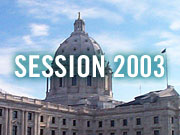Your Voice
| |||||||||||||||||||||||||||||||||||||||||||||
Governor's budget-cutting power is as obscure as the name
January 31, 2003
St. Paul, Minn. — (AP) - Gov. Jesse Ventura threatened it, but never pulled the trigger. Gov. Arne Carlson was ready for it, but was saved by an improving economy. Gov. Rudy Perpich used it, but sparingly. Gov. Al Quie did it too, but he suffered serious political damage.
Unallotment, an awkward word used to describe the governor's power to cut spending in times of fiscal crisis without consent from the Legislature, is creeping back into the vocabulary at the Capitol. Lawmakers are trying to fix a projected $356 million shortage in the 2003 state budget.
Republican Gov. Tim Pawlenty wants the House and Senate to bury huge differences by Friday or he said he will fix the problem himself.
"We're ready to go on unallotment if we need to go," his chief of staff, Charlie Weaver, said Friday. "It's much tougher than the governor's proposed solution in terms of impact. It will be felt much more deeply."
The rarely used law vests enormous power in the executive branch, led by the governor, to reverse previous spending decisions to balance the state budget. The statute, amended numerous times since it was enacted in 1973, is ambiguous in spots, which has prompted disagreement over its parameters.
Here, in question and answer form, are the nuts and bolts of the budget-cutting law: Q: What is unallotment?
A: The executive branch can delay, reduce or cancel unspent payments - known in government parlance as allotments - when it is probable that money coming in will fall short of the amount due to go out. In this case, the most recent economic forecast projects a shortfall of $356 million in the general treasury by June 30, the end of the fiscal year.
Q: Why not just run a deficit?
A: Unlike the federal government, the Minnesota Constitution requires a balanced budget.
Q: Why hasn't Pawlenty done it already?
A: It takes some of his preferred options off the table.
For example, Pawlenty couldn't seize $130 million in cash for road projects and issue bonds instead, which was the biggest move in his own, earlier proposal for fixing the problem. Only the Legislature can authorize borrowing.
With only five months remaining in the budget year, there's not a lot of unspent money laying around for him to grab. Some fear that he could be left to pull more from colleges or even reduce aid to K-12 schools, which he is attempting to keep whole.
Q: What are the limitations?
A: The finance commissioner, acting on behalf of the governor, has a lot of latitude. The commissioner must consult with and notify senior legislators, but they have no formal power to alter the decisions. A meeting with the Legislative Advisory Commission is tentatively set for Wednesday, where the administration would lay out its unallotment framework, Weaver said.
The cuts don't have to be across-the-board cuts nor are there limits on how much can be taken from any particular program.
Minnesota parcels out money from different funds, with the general fund the most common source. The reductions must come from the fund where the deficit is expected to occur, although it's not clear whether money transferred between accounts can be touched.
For instance, a $59 million Iron Range development fund caught up in the budget battle technically rests outside of the general fund. Contrary to what some lawmakers believe, administration officials argue that it is fair game because general tax dollars built the account. If it comes to unallotment, groups looking to protect pots of money dear to them could put up a fight.
The law appears to require the finance commissioner to drain the state's budget reserve first, but that account was tapped out during last year's budget balancing efforts.
Q: What is the lasting impact?
A: There is some debate on this point. When unallotment occurs, the executive branch is canceling expenditures but not the laws authorizing money to be spent. Once a projected deficit is fixed, laws that were "delayed or suspended" appear to regain their potency. But the money withheld to plug the hole is probably gone. It would likely require separate action to restore any lost funds.
Q: Why wouldn't the governor just erase the entire deficit this way? (The state faces another $4-plus billion in estimated deficit through 2004-05).
A: Technically, there is no budget in place for 2004-05. The governor must submit a new budget in mid-February for those two fiscal years, the first of which begins July 1. A few programs have standing appropriations, but the majority are reauthorized each budget cycle. Without actual appropriations there aren't allotments made, and so no unallotment can occur.
Q: When was it used before?
A: According to the Department of Finance, Perpich, a Democrat, cut $110 million from state agency budgets in May 1986 after the state's reserve was depleted.
In the early 1980s, the last time the budget situation was as dire as today, Quie resorted to unallotment to deal with a fiscal problem that dogged lawmakers for years. The Republican governor came under fire for withholding school payments and local government aid. His popularity suffered greatly over the way he handled the budget crisis, and he didn't seek re-election in 1982.
|
News Headlines
|
Related Subjects
|

